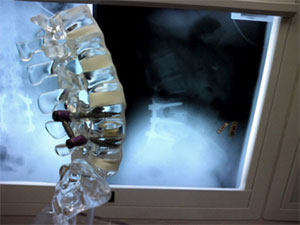

Case Sharing
In the early summer of 1990, I had received a long period of physical training in the disciplined forces. I was only 25 years old and never expected to start fighting against the disease of “sciatica" for life. Back then, for unknown reasons, my feet started to feel numb and tingling.
Since not many people knew chiropractors in Hong Kong back back then, it was even more difficult to find a chiropractor for treatment. The last thing is to accept the advice of a privately practiced orthopedic surgeon which is surgery. at the Precious Blood Hospital, I had the first operation on my back at the Precious Blood Hospital, removing the protrusion of the intervertebral disc, I thought this would be the cure.
The midsummer of 1995 was a turning point in my life. I transferred the position of a clerk, and it was almost before I got married. The disc protrusion condition recurrence. Once again, my entire left leg was numb, and the pain in my lower back was even worse. The pain was much greater than the previous one, I did not have the energy to get out of bed.
Facing with illness, family and work pressures, it is frustrating and I am on the verge of collapse. There’s no more time for me to explore. At the age of 30, I had a second operation at the Baptist Hospital on the advice of another orthopedic surgeon in private practice. Same operation, the protrused disc was also removed.
Even with these two surgeries, it does not help this stubborn disease. In 2001, it was also a mid summer day. Although a few months ago, I had been diagnosed/treated by Dr. Wong. But because I didn’t follow Dr. Wong’s advice to strengthen the lower back muscles and pay attention to my posture. It accumulated time after time, causing the condition to develop rapidly again. In just a week, I can’t get out of bed. Even lying on the bed, the numbness of the legs and low back pain. Accompanied by my wife and my three-and-a-half-year-old son, I was taken to Shatin Prince of Whale Hospital by ambulance. Morphine is needed every day to relieve pain, after the magnetic resonance scan, it was found that the intervertebral disc protrusion was more severe than the previous two times. Without surgery, I may be at risk of disability.
However, because of the second operation, the condition of the back is very unstable. The risks of surgery are high. In this way, I made up my mind to face it positively. The moment I entered the operating room, my mood was calm and not disturbing. It’s calm because I’m familiar with it. What bothers me is the pressure I bring to my family. Fortunately, thanks to the doctor’s hard work, a spinal fusion was done.
After that, Dr. Wong took on the important task of treating me and provided regular spine care maintainence. During these seven years, although there have been several times of recurrence. Fortunately, Dr. Wong’s timely treatment can alleviate the pain every time. If Hong Kong had chiropractors 20 years ago, it would be better for me! A trusted doctor will reduce a lot of unnecessary pain for you.
Case Analysis
The disc protrusion of the patient became more serious than ever, because the affected area was unstable after the operation, including the ligaments, muscles and surrounding soft tissues were weaker. It was also due to the reduced mobility of the patient’s lower back. It makes the joints become stiff and tense, which increases the pressure on the remaining spine. Therefore, after the operation, if the patient does not do muscle strengthening exercises, does not improve living habits, and corrects wrong postures, the consequences may have to face the surgery again.
Diagnose and Treatment
The patient’s lumbar disc was protruding against the sciatic nerve. The patient felt pain from the buttocks, thighs, calves and soles of the feet. If they stand or walk for too long, they will feel stretched and numbness in the legs, and can’t continue walking. Because the patient’s pain and numbness are very severe, usually the first instinct is to take painkillers and anti-inflammatory drugs, or injection to relieve pain.It takes a very long time for patients to receive non-surgical conservative disc therapy. Patients need great patience, endurance and time to recover. Some patients undergo surgery in the hope of quickly solving their pain, but sometimes surgery is the last resolve after trying all conservative treatment.
The author believes that if the patient’s condition is that the disc is severely protruding, the muscle strength continues to be imbalanced, the sensory nerves continue to be imbalanced or the disc compresses against the cauda equina may cause incontinence. Depending on the severity of the patient, there is no significant improvement in pain after three months of conservative treatment, so they can consider disectomy or spinal fusion surgery.
Of course, some cases include acute disc rupture, the broken disc is severely pressed against the nerves, causing weakness in the legs, loss of leg sensation, incontinence, and low back pain. This requires immediate surgery.

COX® Decompression Manipulation
COX® Decompression Manipulation a set of treatments invented by an American Chiropractor Dr. James M. Cox in the 1960s and has been used for more than 40 years. In academic research, a number of cerifications have also been made to support its effective treatment effect (* Please refer to a number of scientific research studies of COX® Technic). Cox Decompression Manipulation is to use a special decompression table, and then press the patient’s disc protruding section for decompression. After decompression, the nucleus shrinks with dehydration. The shrinkage of the nucleus increases the space for the spinal foramen, and the compressed nerve roots have to be released, so the patient’s foot pain can be improved .
After many months of treatment, the pressure in the disc continue to decrease, allowing enough time for the fibrous annulus in the outer layer of disc to repair. However, if the annulus fibrosus is not completely repaired, when the disc is compressed again, the annulus fibrosus will be torn again, the nucleus pulposus will continue to overflow, and the nerve root will be pressed again to produce pain. Therefore, the patient cannot carry heavy objects, do strenuous exercise, stand and sit for long periods of time, and cannot do fitness, yoga, ball games, dancing, or swimming before they fully recover.

 Book an Appointment
Book an Appointment


